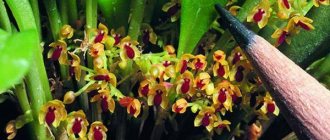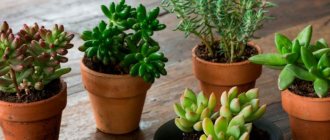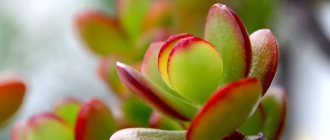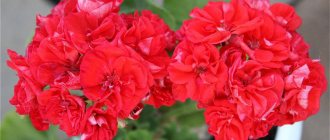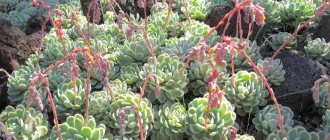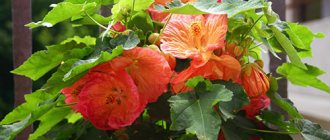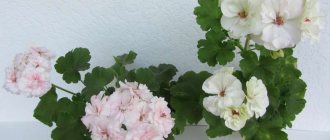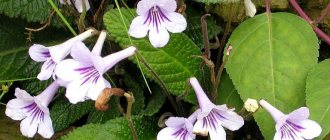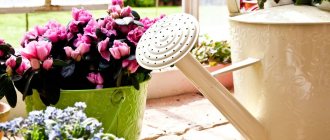Botanical description of succulent with photo
Sedum has the following botanical characteristics:
- leaves – whole, fleshy, alternate or sessile;
- flowers are bisexual, actinomorphic, star-shaped, collected in corymbose, umbellate or racemose inflorescences, characterized by sufficient density;
- rhizome – shortened, with numerous twisted tuberous lateral roots;
- stems are strong, evenly leafy, curved at the base;
- corolla - consists of 5 free petals, approximately 3 times longer than the sepals;
- the fruit is a red or pink multileaf with numerous seeds about 1 mm long.
The height of the plant ranges from 20 to 60 cm.
General description and history of origin
Sedum is a succulent plant from the Crassulaceae family. The appearance is represented by thickened stems, covered with fleshy leaves of a rounded shape, and a tip with an inflorescence. Most are perennials, but there are also biennial representatives.
Appearance of sedum
For your information! In its natural environment it grows in South America, North Africa and part of Russia. This unpretentious plant is also known under the names hare grass, fat grass, young grass, stone rose, creaking grass, living grass, hernia grass.
Translated from Latin, sedum has several meanings:
- “sit” - often spreads along the ground, forming a continuous carpet;
- “pacify” - has analgesic properties.
People valued it for its cleansing properties, hence the Ukrainian name “sedum”.
There are about 500 varieties of sedum in the world, but they are conventionally divided into two groups:
- ground cover. The predominant species with a height of 10 to 30 cm. Spreads along the surface of the earth, conquering new territories and growing rapidly, thereby forming a continuous covering;
- shrubby. A variety of tall sedums that can reach 80 cm in height. They are popular among gardeners, since the only condition is sufficient and timely watering. Otherwise, they do not require care, they can grow on rocky areas and weakly humus soil.
Ground cover sedum forms a continuous carpet on the surface of the earth
Useful properties and contraindications
Thanks to its unique composition, sedum has many beneficial properties:
- antitumor;
- hemostatic;
- anti-inflammatory;
- stimulating;
- regenerating;
- wound healing;
- general tonic.
In addition, the use of drugs prepared on the basis of this plant has a number of healing effects on the body:
- lowering blood pressure;
- eliminating colds;
- calming the nervous system;
- weight normalization;
- normalization of the gastrointestinal tract;
- burning cholesterol.
Only sedum has contraindications. Its excessive use can cause the following symptoms:
- dizziness;
- vomit;
- cardiac and respiratory arrest (with possible coma).
The use of this type of sedum is not recommended for pregnant and lactating women, children, hypertensive patients, as well as people with increased nervous excitability.
Kinds
About 600 species of plants belonging to the genus Sedum are known.
Morgana
Sedum morganianum. The bluish-green leaves of this species can grow up to 1 m. The leaf blades are fleshy, pointed at the tops. The stems look like a Christmas tree. The plant is covered with a slight waxy coating that provides protection from sunburn.
Burrito
Sedum Buritto. Voluminous and low-growing bushes with rounded, fleshy greenish-blue leaves. The plant is covered with a waxy coating that performs a protective function. The flowering period is observed at the end of spring: at this time, soft pink bell buds are formed.
Despite the tight fit to the stem, the leaf blades crumble even with minor mechanical stress.
White
Sedum album. The smooth, cylindrical leaves are quite dense and fleshy. In winter and during the period of active growth, the leaf blades are colored green, and in summer and autumn they acquire a red-brown tint. The white flowers are star-shaped, small, reaching 1 cm in diameter.
Variety Coral Carpet
Of the many varieties of Sedum album, Coral Carpet stands out. The young leaves of the plant have a rich orange-coral color. The height of the peduncles reaches 15 cm, white flowers have a pink center.
Siebold
Sedum sieboldii. The plant has pink-green leaves with a red edge. Spiral-round leaf blades are impressively attached to flexible stems and are the main decoration for most of the year. The height of the bushes is about 25 cm.
The flowering period lasts from September to October and is distinguished by the formation of small dark pink buds.
Caustic
Sedum ácre. A small, bare plant with numerous stems covered with small, dense leaves and a thin rhizome. The inflorescence consists of shortened branches on which flowers with golden-yellow petals are located. Flowering period: late spring-early summer.
Red-colored
Sedum rubrotinctum. The succulent stands out for its woody stems and fleshy green leaves, reminiscent of legumes in their rounded shape. The leaf blades grow up to 2 cm in length. When exposed to sunlight, they acquire a reddish tint. During the flowering period, the plant is covered with small yellow flowers.
thick-leaved
Sedum pachyiphyllum. The upright plant is distinguished by blue-green leaves with a cylindrical shape, growing up to 2.5 cm in length. The leaf blades, folded up, are colored red at the tops. In spring, yellow flowers form on the bush.
Adolf
Sedum adolphii. The plant has light green fleshy leaves covered with a light coating. The inflorescence of white flowers is hemispherical, lateral, reaching a length of 12 cm.
In bright sunlight, the leaf blades take on a reddish tint.
Large or regular
Sedum telephium. The perennial grows up to 50 cm in height and may have one or more stems that die off in winter and emerge from the rhizome buds in the spring. On each stem there are dense, alternately arranged dense petiolate leaves. The inflorescences consist of a large number of flowers, the color of which can be pink, purple or crimson.
Common sedum is most often grown in open ground. The varieties most suitable for indoor conditions are Linda Windsor and Matrona.
Potozinsky
Sedum potosinum. Perennial succulent with creeping shoots that later rise. The leaf blades are obtuse, sessile, light green with a whitish tint. The tops of the leaf blades are pinkish-purple. During the flowering period, the plant is covered with white buds.
Steel
Sedum Stahlii. The shoots of the plant reach a height of up to 20 cm. The ovoid leaves fit tightly to the stem.
The leaf blades are red-brown in color.
Linear
Sedum lineare. A highly branching, creeping perennial has linear or linear-lanceolate leaves up to 2.5 cm long. The color of the leaf blades is light green. During the flowering period, yellow buds are formed.
Weinberg
Sedum weinbergii. A plant with recumbent and erect fleshy branches. The ovoid leaves with a pink-green tint are covered with a waxy coating. The color of the flowers is white.
Gregg's or variegated
Sedum greggii. The succulent is distinguished by gray-green leaves with an ovoid shape, twisted in an amazing way and resembling cones. During the flowering period, yellow buds form on the peduncle.
Compact
Sedum compactum. The plant has small gray-green leaves with a retracted ovoid shape. The flowering period is observed in the first half of summer: 2-3 white buds with a pleasant aroma appear on the peduncle.
Description of the plant
Sedum is a low-growing herbaceous succulent plant. All types of sedums can be divided into two groups. The first includes heat-loving species, which in our climate are grown indoors as perennials or as annual crops in open ground. The second group includes frost-resistant perennial ground cover species of sedum. In Russia, under natural conditions, they grow mainly in the Caucasus.
The stems of sedums are quite branched and, when growing, form a lush shrub or subshrub.
Their leaves are very dense. They are sessile, have no petioles, and adhere well directly to the fleshy stems. The leaf blades are fleshy, whole, arranged alternately. They are opposite or whorled. In addition, the shape of the leaf blade, its color and size vary greatly among different types of sedum. There are specimens with leaves that are swollen, like cylinders, or with flat leaves, like disks.
The leaf plates are painted not only in the traditional green color, but also in pink, gray, gray, reddish and others. Moreover, the color of the leaves depends not only on the variety or type of sedum. Even the same species can differ in foliage color if its growing conditions are noticeably different. The composition of the soil in the pot also affects the color of the leaves. Overfeeding causes colors to fade. Sometimes reddish stains appear on the leaves of sedum.
The inflorescences are also different: lateral and apical, in shape - corymbose, umbellate and racemose. The flowers in the inflorescences are bisexual, star-shaped, of various colors: red, yellow, snow-white, blue. The petals are very dense, slightly bent. As they grow, they grow together into a narrow tube, from which numerous stamens and the ovary peek out. Sedum blooms at any time of the year, depending on the type and variety. Most often at the end of summer or autumn. This is a honey plant. The flowers smell so pleasant that with their aroma they attract not only people, but also numerous pollinating insects: butterflies, bumblebees, and bees.
Since in nature sedum often grows on steep cliffs and large stones, as if hanging from them, it can also be grown in an apartment as an hanging plant in hanging flowerpots.
Sedum (sedum) is a relative of such indoor flowers as Kalanchoe, young, echeveria and spotted petal.
Home care
Most types of sedums are unpretentious. However, caring for them requires following basic rules.
Temperature
Recommended temperature in summer is +25-28 degrees, in winter – +14-18 degrees.
Location and lighting
Sedum is a light-loving plant that needs bright sunlight. Therefore, to place it, you should choose windows facing south.
In winter, the succulent requires lighting.
Watering and spraying
Sedum stores water in its fleshy leaves and slowly evaporates it. Therefore, watering should be quite moderate: in summer - once a week, in winter - 2 times a month. Occasionally, the plant can be sprinkled with warm water to wash away dust and other contaminants.
Choosing a pot or flowerpot
Due to the small root system of sedum, low, wide containers equipped with a drainage system are well suited for its cultivation. Since the plant's roots develop slowly, it is not necessary to change the pot to a larger one when replanting.
Priming
To plant sedum, you can purchase a ready-made substrate for succulents or prepare it yourself using the following components:
- leaf soil (1 part);
- turf (1 part);
- sand (1 part);
- charcoal;
- crushed brick.
Another recipe includes the following components: sand, humus and peat, taken in a ratio of 1:1:2.
Flowering and dormant period
During the flowering period, sedum requires a large amount of sunlight. Therefore, it is best to take a flower grown indoors to a balcony or veranda. During the dormant period, it is better to leave it in a room with a temperature of no more than +18 degrees, reducing watering and completely abandoning fertilizing.
Landing
The frequency of replanting a young plant is once every 2 years, an adult plant is once every 3-4 years. The procedure should be performed as carefully as possible due to the fragility of the sheet plates.
Top dressing
Sedum is fed from the beginning of spring until the first half of autumn. For this purpose, special formulations for cacti are used, which are applied once a month. During the dormant period, the plant does not need fertilizing.
How to propagate?
There are several ways to propagate sedum: by leaf, by dividing the bush, by seeds, by cuttings. The last two are considered the most common.
From seeds
This technology allows you to simultaneously grow a large number of sedums. The procedure is carried out in spring or autumn. The seeds are mixed with dry sand, placed in pre-moistened soil, and then a small greenhouse is set up. With proper care, the first shoots appear within 2 weeks.
How to root cuttings in the fall?
Planting cuttings must be carried out immediately after cutting.
It is advisable to carry out the procedure in the fall. Planting material is planted in a light and loose substrate, using a wide but low bowl. Rooting will occur in approximately 14-20 days, and after another 2 weeks, young plants are planted in separate containers.
Diseases and pests
With proper care, it is rarely susceptible to disease. However, if the watering regime is violated, the underground and above-ground parts of the plant are affected by various fungi. To eliminate the problem, damaged specimens are dug up and treated with fungicides.
Harmful insects love the lush greenery of the succulent and attack it throughout the growing season. Particularly often attacked:
- aphid;
- thrips;
- grooved mower;
- caterpillars;
- sawflies.
The collected insects are destroyed, and the bushes are treated with acaricides or insecticides.
Also, such folk remedies as tincture of marigold, tansy, dandelion, nettle, and tree bark give good results.
Reproduction methods
There are several ways to propagate sedum.
Some methods can be used in any season, others - in a specific one. In any case, the seedlings of this plant are unpretentious. The main thing is to protect them from severe frosts and excessive sun. Let's look at the two most common methods of reproduction.
Cuttings
This propagation method is simple, short and the most reliable. Even a child can take cuttings, under the strict guidance of his parents . To propagate sedum in the autumn, just cut the cutting at an angle and sprinkle it with soil. At this stage it should be placed in a dark and cool room.
If you dig up a young plant that has already taken root and replant it, there is a high probability of its death.
You can cut sedum at any stage of its development . This is done as follows:
- 5 cm of the above-ground part of the shoot is cut off;
- the stalk is freed from a pair of leaves located below;
- The cut shoot is pressed into the pre-loosened soil;
- the soil is cleared of weeds and leveled;
- Additionally, the cuttings are sprinkled with earth and sand.
Water the cuttings as the soil around them dries.
In winter, the cutting method is used for subsequent landscaping, because quite a lot of seedlings are obtained. You need to take cuttings in winter after flowering:
- It is important to choose the healthiest and most beautiful flower shoots and cut them off.
- Next, they need to be dried at positive temperatures.
- When dried, the leaves fall off and young shoots with small roots grow. When they reach 4 cm, they should be separated and planted in special containers.
- Ideally, keep young cuttings at room temperature.
- Direct sunlight should be avoided.
- At the end of the spring season, shoots can be planted in open areas.
Seeds
At home, the method of propagation using seeds is used in the spring. In open areas, it is better to sow seeds just before the start of winter.
Important! To propagate sedum in the spring, you need to imitate winter conditions to make it easier for the seeds to germinate.
Propagation of sedum using seeds:
- Take a small container, fill it with soil and sow the seeds.
- The earth is moistened.
- The container is covered with a glass lid or transparent film, or simply put into a bag that needs to be tied.
- Next, the container is placed on the bottom shelf in the refrigerator. The temperature of the refrigerator compartment is set within 5-7 degrees above zero.
The sedum should be stored in the refrigerator at a constant temperature for 14 days. The main thing is to periodically check the soil moisture and oxygen access to the seeds. It is recommended to open the lid and spray the soil daily.
After 14 days, the container should be moved to a warm room. Recommended temperature range is 18-20 degrees above zero.
If all the rules are followed, the first shoots should appear in 14-28 days . At the moment when the first leaves appear on the small sprouts, they should be planted in separate containers.
Growing in open ground
Sedum bushes are frost-resistant and are well suited for growing in areas with infertile soil. An important condition for the successful growth of perennials is well-drained soil. The recommended time for planting is April and May.
During the growing process, the sedum is watered moderately and fed with compounds for garden plants. Weed as necessary. In the spring, after the first frost has passed, the plant is pruned.
Despite its frost resistance, it is recommended to protect the plant from exposure to low temperatures by creating a shelter for it from fallen leaves, pine branches or agrofibre.
Pests, diseases and possible difficulties
- Sedums rarely get sick or are affected by pests.
- Most often, sedum is affected by mealybugs, which hide in the axils of the leaves. Remove pests with a cosmetic stick and treat the plant with an insecticide.
- Leaves may wilt or wrinkle when the soil dries out. Water the plant, and most likely the turgor will be restored.
- When overwatered, especially in combination with low temperatures, the roots and bases of the stems can easily rot.
- Leaves may fall off after transplanting.
- Internodes stretch out in insufficient light.
Useful video
How to properly prune a plant when it begins to stretch, watch the video:
Original compositions from sedum can be created both in personal plots and in residential or office premises. With timely and proper care, the plant will delight you with its beauty for many years.
READ ABOUT OTHER SUCCULENTS: GASTERIA, COTYLEDON, GRASSWORTH, LITHOPS, REJUVEN, a href=”https://botanicoved.com/komnatnye/sukkulenty/raznovidnosti-sukkulenty/pahifitum.html” rel=”noopener” target=”_blank”> PACHYPHYTUUM, PORTULACARIA, SEDEVERIA, STAPELIA, HAWORTIA, EONIUM, ECHEVERIA.
